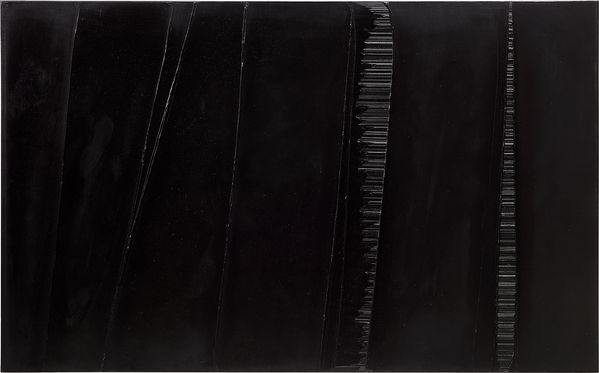Pierre Soulages, Peinture 80 x 130 cm, 1er mars 1987, 1987.
Pierre Soulages: Une Lumière Infinie.
—Written by Jesse Limbacher
Few artists across disciplines were as innovative as Pierre Soulages and the composer Gérard Grisey. It took time for culture to catch up to their expressions of physicality and light. At first, the work of these two artists may seem dark and brooding, but there is another way to see and hear it.
Read (and listen) below, as I chat with Phillips' own Nathalie Zaquin-Boulakia. Join us as we explore similarities between the peers and dive into what makes their works glow.
Exhibition /
Phillips X + ARCHEUS / POST-MODERN
Pierre Soulages: Une Lumière Infinie
London Exhibition. On View 1 February – 12 February
Learn more >
Digging In
From an early age Pierre Soulages was obsessed with the color black. He often laughed at a story from his childhood — his older sister found him spreading black ink across a sheet of paper, “What are you painting?” she asked the young artist. “Snow,” he replied.
In the early works that used black in contrast to white space or another color, it was never about black. Black was used to create the glow of contrast with white space, a transparency, or another color. In the Outrenoir or ‘beyond-black’ works it’s about the glow of light refracting off various surface treatments of black paint. The paintings are, “not about black at all,” Nathalie tells me. “It’s about the light.”

Pierre Soulages, Eau-forte Xa, 1957.
Pierre Soulages: Une Lumière Infinie.
Price on Request | View >
The work of French composer Gérard Grisey, well known only in contemporary-music circles, can be equally misunderstood at first listen. His work liberates what sound can mean to us. There is a way to hear his use of dissonance and microtones (the notes you can imagine existing between the white and black keys of a piano) that goes beyond our typical cultural associations with these sounds.
Grisey’s works are focused on the nature of sound and the overtones of the harmonic series. It was not the composer’s intention to impress any dark aesthetic expression. His works often explore how the harmonic series alters our hearing of a single pitch — the musical equivalent of light reflecting off a single color.
Grisey is commonly considered to be the chief composer of the Spectral movement. This revolutionary style emerged in midcentury Paris and is the French reaction to the Germanic Expressionist discourse dominating the arts at the time.
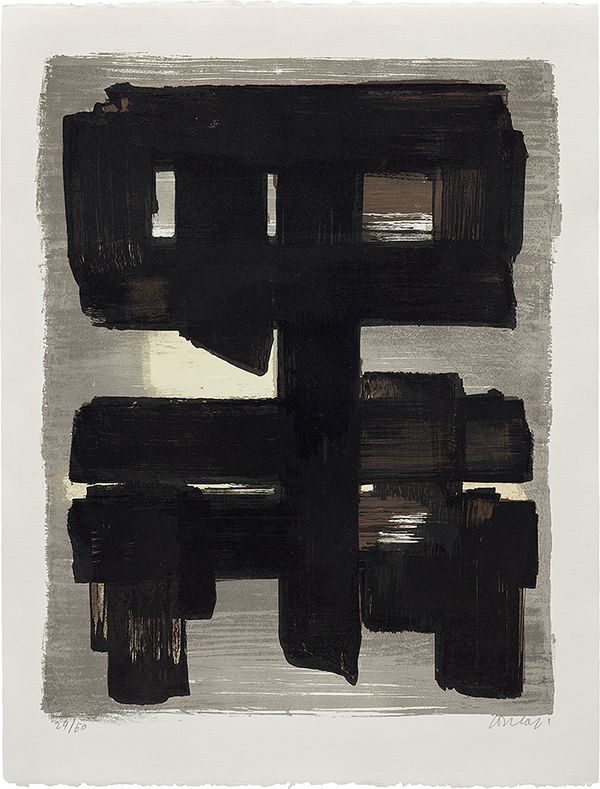
Pierre Soulages, Lithographie n° I, 1957.
Pierre Soulages: Une Lumière Infinie.
Price on Request | View >
It's not by accident that the musical term for tone-color — timbre — is a French word.
The obsession with tone-color in French music can be traced back to Impressionist composers like Ravel and Debussy. One can hear a line through history from those Impressionist works to the synesthetic sensibility of Olivier Messiaen (who was Grisey’s teacher), to the sonic expressions of Edgar Varèse (his acoustic works often include those vintage hand-cranked sirens), and ultimately to the emergence of Spectral music.
“Can a similar sort of transversal history be felt for Soulages by the French?” I ask Nathalie.
“His work is certainly in the path of the history of art in France,” she explains. “But when the French think of Soulages, he really belongs to this category of artists who are the most important representative artists of the French Abstraction that emerged after the Second World War.” She adds, “He had very early success in the US and Germany, but in his home country, the success came later.”
I do not depict. I do not describe. I do not represent. I paint, I present.
—Pierre Soulages
Black Light
“When Soulages jumped into this Outrenoir period in ’79, it was then that he really stopped working with black as a color,” Nathalie explains. “He was working with black as a reflection of the light.”
Soulages uses the black surfaces of his Outrenoir works to refract spectra of light, leaving an indelible impression on viewers. Grisey and the Spectral composers were focused on manipulating certain naturally occurring overtones of musical pitches to the same end. The microtones and harmonies traditionally considered dissonances are not used here to create discordance, but to reflect the natural beauty of sound.
“The black was only used to reflect the light and he was playing with this black to create vibration,” Nathalie says. “It’s a vibration, and I think it’s probably the closest aspect in his work to music.”
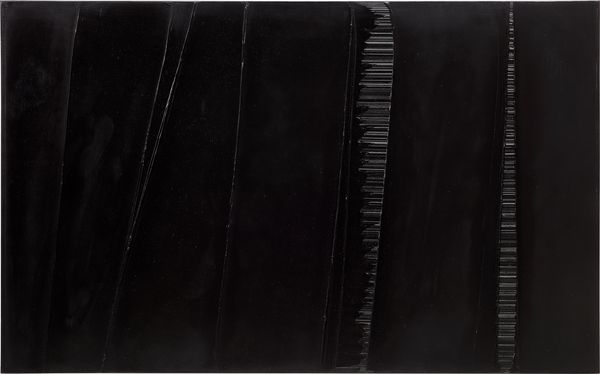
Pierre Soulages, Peinture 80 x 130 cm, 1er mars 1987, 1987.
Pierre Soulages: Une Lumière Infinie.
Price on Request | View >
What gives a musical note its timbre is the composition of the partials of the harmonic series in its waveform. It gets a bit scientific, but, for example, your ears know they’re hearing a clarinet and not a violin because you are hearing different ‘spectra’ or groups of overtones. The ‘fundamental’ frequency (the actual note each musician plays) is the same, but the overtones are different.
I ask Nathalie if this idea of varying the timbres of a musical pitch can be seen in the variety of ‘blacks’ used by Soulages. “The light has vibrations," she says, "and depending on the way he’s going to work on the black or flatten it or make it glossy, or with different lines on the surface — he plays with this vibration of the light. It appears differently on the canvas.”
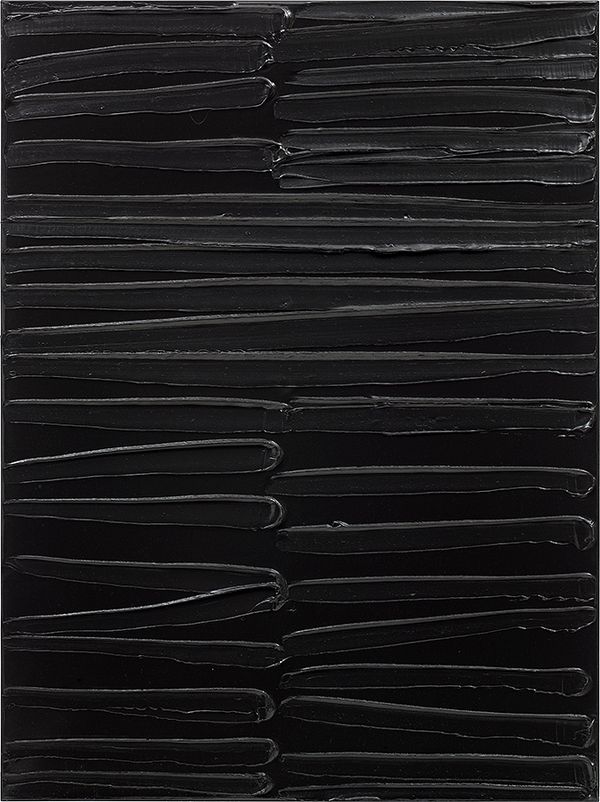
Pierre Soulages, Peinture 130 x 97 cm, 28 février 2007, 2007.
Pierre Soulages: Une Lumière Infinie.
Price on Request | View >
Below, use the tool to hear the individual overtones in the harmonic series. The wave on the left is the fundamental, and each of the first 15 partials of the fundamental are to the right.
As you move further to the right, you’ll start to hear microtones. The western tuning system that resulted in just 12 pitches in each octave does not have enough notes to express the full harmonic series. However, it’s a natural phenomenon so it should sound familiar. (Tool Courtesy of Alexander Chen via Github).
Grisey’s Partiels and Soulages’ Outrenoir
A painting by Pierre Soulages is like a chord on a vast piano struck with both hands simultaneously — struck and held.
—James Johnson Sweeny
In the below excerpt from the first bars of Grisey’s seminal work Partiels, for 18 musicians, we first hear a low note — ‘E’ — articulated in the bass trombone. In the higher pitches above it, Grisey paints the spectrum of partials of the overtone series.
Now hear three gestures from a little later in the work, as Grisey highlights different overtones of the same pitch — a musical analogy of light playing on Soulages' all-black canvases. Can you hear the differences?
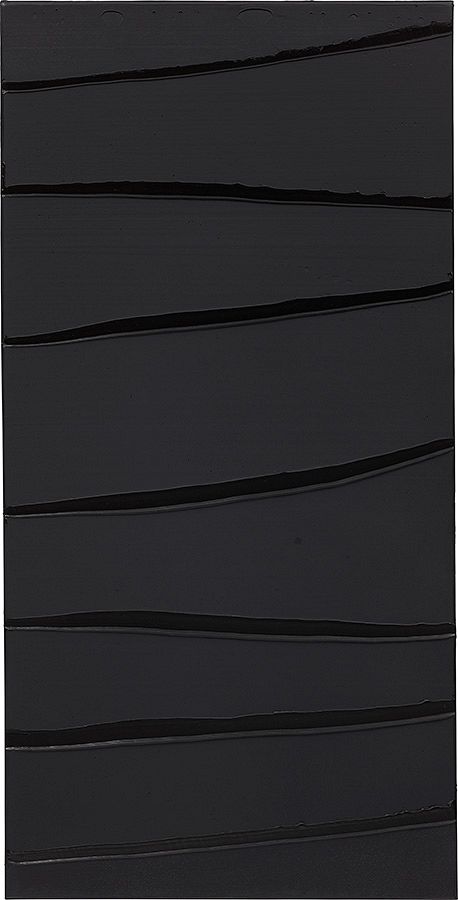
Pierre Soulages, Peinture 181 x 91 cm, 7 avril 2007, 2007.
Pierre Soulages: Une Lumière Infinie.
Price on Request | View >
In his 1957 essay Modernist Painting, Clement Greenberg defines Modernism as, “The use of the characteristic methods of a discipline to criticize the discipline itself — not in order to subvert it, but to entrench it more firmly in its area of competence.” A few years later, French composer Edgar Varèse paved the way for Spectral composers with a similar idea. In his 1966 essay The Liberation of Sound, music’s “area of competence” (to use Greenberg’s term) is simply sound, liberated from the way we think of melodies and harmonies. Varèse’s definition of music as “organized sound” and his consideration of “musical space as open rather than bounded” spoke to the intrinsic in music in the same way that Greenberg’s expression of "flatness" did for painting.
“There is a similarity for sure,” replied Nathalie when I ran this idea by her. “I think in both cases — pigments and sounds organized in space and time — they are both filling the space. For the music, it’s a silence. For painting, the blank canvas is a kind of silence.”
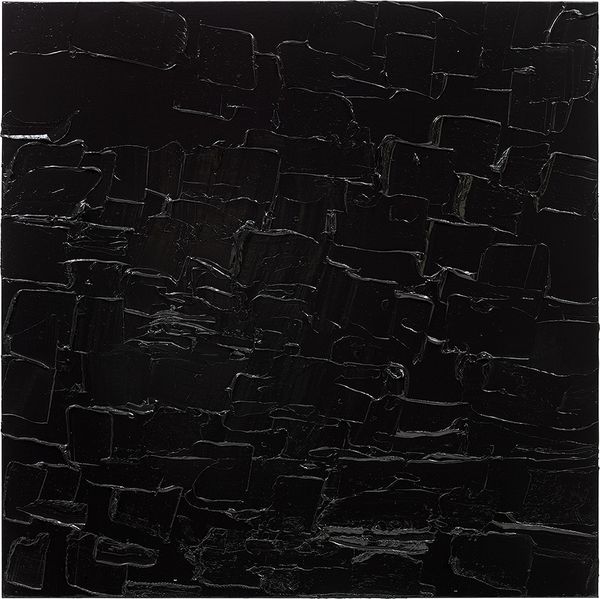
Pierre Soulages, Peinture 130 x 130 cm, 16 juillet 2021, 2021.
Pierre Soulages: Une Lumière Infinie.
Price on Request | View >
It’s clear the Spectral composers were influenced by Varèse’s ideas. They needed a great expanse of time and space to express their focus on the intrinsic aspects of sound. Grisey described his style as “music which is more a state of sound than a discourse.” In his music we can find an inherent sonic presence and a rejection of traditional notions of melody and counterpoint. Similarly, Soulages told Interview magazine in 2014, “I am against limitations like perspective. Perspective is illusion, it’s the opposite of presence, and art is presence.”
Below, hear how much the “state of sound,” has changed in Partiels by the time we near the end of the work. Notice that Grisey is still focused on partials of the harmonic series above that same low ‘E.’
(Interpretation of Gérard Grisey’s Partiels for 18 musicians by Ensemble Court-circuit, Pierre-André Valade, conductor).
"There Are No Minor Works"
Well all those terms — abstract, nonfigurative, etc. — they’re just words, they’re labels, and labels are meant to be destroyed.
—Pierre Soulages
Grisey rejected the term Spectralism. He told David Bündler for 20th Century Music magazine in 1996 (just two years before his death) “Spectralism is not a system. It’s not a system like serial music or even tonal music. It’s an attitude. It considers sounds, not as dead objects that you can easily and arbitrarily permeate in all directions, but as being like living objects with a birth, lifetime, and death.”
At first, Grisey’s works were overshadowed by the prevailing academic trends of the day. What he accomplished took time for musical culture to understand. His most important body of work, Espaces acoustiques, was completed in 1985 and wouldn’t be performed in its entirety for over a decade.
I ask Nathalie if there were any similar struggles for Soulages.
“Oh yes, I think that the first twenty years of his career were not very easy,” she says. “He was not on trend. What was fashionable at the time was abstraction with very strong colors. Color was very linked to abstraction, so he had to face a lot of criticism. Museums and institutions were very supportive of his work, but it took time for the public to understand — it’s not obvious.”

Pierre Soulages, Sérigraphie n° 2, 1973.
Pierre Soulages: Une Lumière Infinie.
Price on Request | View >
Grisey is often thought of as a very calculated composer, but there is more to the story. To achieve his expressive results required intense, scientific study of sound at IRCAM (that’s the French government-funded institute for the research of sound or Institut de recherche et coordination acoustique / musique— s’il vous plaît). However, the strength of his oeuvre lies in the discovery of a new type of dramatic expression which required a certain amount of intuition from the composer — what he describes as “the completely enormous subconscious aspect of writing music — which I am totally unaware of what I am doing.”
Nathalie similarly notes of Soulages, “It took him a very long time before starting a painting. It was not impulsive. When he started, he didn’t know where it was going. It’s not like he was jumping on the canvas. It took him a long time.” Soulages’ study of and experimentation with his materials mirrors Grisey’s process at IRCAM. Nathalie explains, “Especially with the Outrenoir, he used different mediums and sometimes mixed paint with resin to achieve a thicker texture. The process was also very physical — these works are often of a massive scale. He was really playing with the medium, using special tools.”
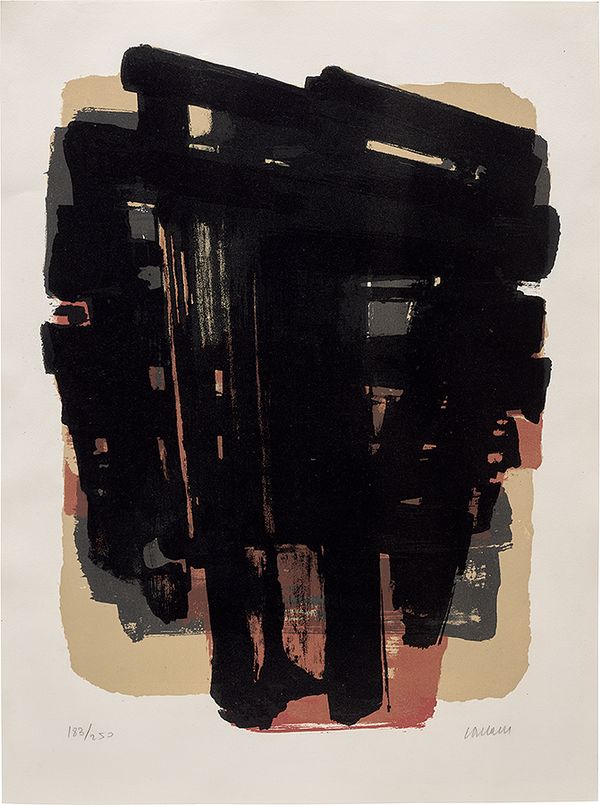
Pierre Soulages, Lithographie n° 8, 1958.
Pierre Soulages: Une Lumière Infinie.
Price on Request | View >
Grisey only left us works that really mattered to him. In the eminent British composer Julian Anderson’s obituary of Grisey he described him as “a thoughtful man and a fastidious composer,” going on to write, “There are no minor works.” This also rings true for Soulages, who would incinerate works that he felt were not communicative enough.
The word "physical" can describe the process for both artists. As Grisey explained, “I personally start more with the physical aspect of things, the physical aspect of sounds, of different spectrums, the quality of spectrums. And I leave the rest…the cultural aspect, to the audience. To the listener.”
Says Nathalie of Soulages, “He didn’t want to think about what was going on outside of himself. He was very independent and never followed any school or artistic movement." She continues, "It was something coming from inside of himself. The work was done without any influence. He was touched by everything primitive — in the sense of that which has not been spoiled by any culture.”
Approach with open ears and you’ll find the same can be said of Grisey.
Nathalie Zaquin-Boulakia is Regional Director of France and Senior International Specialist of 20th Century & Contemporary Art at Phillips.
Playlist: The Phillips Guide to Gérard Grisey
Exhibition /
Phillips X + ARCHEUS / POST-MODERN
Pierre Soulages: Une Lumière Infinie
On View 1 February – 12 February
30 Berkeley Square, London, United Kingdom, W1J 6EX (map)
Learn more >
Recommended Reading
Paris 1957: Soulages swallows the soul of La Vie Existentielle >
